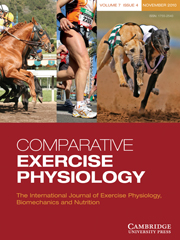Crossref Citations
This article has been cited by the following publications. This list is generated based on data provided by
Crossref.
Evans, Rebecca Gay
and
Lowder, Michael
2012.
Examination of the Depth of the Equine Hard Palate.
Journal of Veterinary Dentistry,
Vol. 29,
Issue. 4,
p.
228.
Casey, Vincent
McGreevy, Paul D.
O'Muiris, Eoghan
and
Doherty, Orla
2013.
A preliminary report on estimating the pressures exerted by a crank noseband in the horse.
Journal of Veterinary Behavior,
Vol. 8,
Issue. 6,
p.
479.
Eisersiö, M.
Roepstorff, L.
Weishaupt, M.A.
and
Egenvall, A.
2013.
Movements of the horse’s mouth in relation to horse–rider kinematic variables.
The Veterinary Journal,
Vol. 198,
Issue. ,
p.
e33.
Hawson, Lesley A.
Salvin, Hannah E.
McLean, Andrew N.
and
McGreevy, Paul D.
2014.
Riders' application of rein tension for walk-to-halt transitions on a model horse.
Journal of Veterinary Behavior,
Vol. 9,
Issue. 4,
p.
164.
Björnsdóttir, Sigríður
Frey, Rebecka
Kristjansson, Thorvaldur
and
Lundström, Torbjörn
2014.
Bit-related lesions in Icelandic competition horses.
Acta Veterinaria Scandinavica,
Vol. 56,
Issue. 1,
Pierard, Marc
Hall, Carol
König von Borstel, Uta
Averis, Alison
Hawson, Lesley
McLean, Andrew
Nevison, Charlotte
Visser, Kathalijne
and
McGreevy, Paul
2015.
Evolving protocols for research in equitation science.
Journal of Veterinary Behavior,
Vol. 10,
Issue. 3,
p.
255.
Eisersiö, Marie
Rhodin, Marie
Roepstorff, Lars
and
Egenvall, Agneta
2015.
Rein tension in 8 professional riders during regular training sessions.
Journal of Veterinary Behavior,
Vol. 10,
Issue. 5,
p.
419.
Guire, R.
Mathie, H.
Fisher, M.
and
Fisher, D.
2017.
Riders’ perception of symmetrical pressure on their ischial tuberosities and rein contact tension whilst sitting on a static object.
Comparative Exercise Physiology,
Vol. 13,
Issue. 1,
p.
7.
Dyson, Sue
2017.
Equine performance and equitation science: Clinical issues.
Applied Animal Behaviour Science,
Vol. 190,
Issue. ,
p.
5.
Doherty, Orla
Casey, Vincent
McGreevy, Paul
McLean, Andrew
Parker, Pierce
and
Arkins, Sean
2017.
An analysis of visible patterns of horse bit wear.
Journal of Veterinary Behavior,
Vol. 18,
Issue. ,
p.
84.
Doherty, Orla
Casey, Vincent
McGreevy, Paul
Arkins, Sean
and
Munderloh, Ulrike Gertrud
2017.
Noseband Use in Equestrian Sports – An International Study.
PLOS ONE,
Vol. 12,
Issue. 1,
p.
e0169060.
Dyson, Sue
Berger, Jeannine M.
Ellis, Andrea D.
and
Mullard, Jessica
2017.
Can the presence of musculoskeletal pain be determined from the facial expressions of ridden horses (FEReq)?.
Journal of Veterinary Behavior,
Vol. 19,
Issue. ,
p.
78.
Doherty, Orla
Conway, Thomas
Conway, Richard
Murray, Gerard
Casey, Vincent
and
Munderloh, Ulrike Gertrud
2017.
An Objective Measure of Noseband Tightness and Its Measurement Using a Novel Digital Tightness Gauge.
PLOS ONE,
Vol. 12,
Issue. 1,
p.
e0168996.
Mullard, Jessica
Berger, Jeannine M.
Ellis, Andrea D.
and
Dyson, Sue
2017.
Development of an ethogram to describe facial expressions in ridden horses (FEReq).
Journal of Veterinary Behavior,
Vol. 18,
Issue. ,
p.
7.
Benoist, Caroline C.
and
Cross, Graham H.
2018.
A Photographic Methodology for Analyzing Bit Position Under Rein Tension.
Journal of Equine Veterinary Science,
Vol. 67,
Issue. ,
p.
102.
Veen, I.
Killian, D.
Vlaminck, L.
Vernooij, J. C. M.
and
Back, W.
2018.
The use of a rein tension device to compare different training methods for neck flexion in base‐level trained Warmblood horses at the walk.
Equine Veterinary Journal,
Vol. 50,
Issue. 6,
p.
825.
Dyson, Sue
Berger, Jeannine
Ellis, Andrea D.
and
Mullard, Jessica
2018.
Development of an ethogram for a pain scoring system in ridden horses and its application to determine the presence of musculoskeletal pain.
Journal of Veterinary Behavior,
Vol. 23,
Issue. ,
p.
47.
Dyson, Sue
Berger, Jeannine M.
Ellis, Andrea D.
and
Mullard, Jessica
2018.
Behavioral observations and comparisons of nonlame horses and lame horses before and after resolution of lameness by diagnostic analgesia.
Journal of Veterinary Behavior,
Vol. 26,
Issue. ,
p.
64.
Dumbell, Lucy
Lemon, Chloe
and
Williams, Jane
2019.
A systematic literature review to evaluate the tools and methods used to measure rein tension.
Journal of Veterinary Behavior,
Vol. 29,
Issue. ,
p.
77.
Mellor, David J.
2020.
Mouth Pain in Horses: Physiological Foundations, Behavioural Indices, Welfare Implications, and a Suggested Solution.
Animals,
Vol. 10,
Issue. 4,
p.
572.

